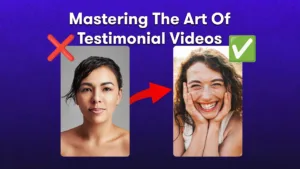Mastering The Art Of Testimonial Videos: A Comprehensive Guide to Creation And Implementation
After a five-year stint in corporate marketing in California, Lucas decided to hang up the suit and tie for a more relaxed setting. He moved to Barcelona to get his MBA and enjoy the Mediterranean lifestyle. After spending 15 months in Europe, Lucas moved back home to Reno, Nevada where he started his own digital marketing company, StratMark. When he is not working, Lucas is out skiing, rock climbing, mountain biking, and just enjoying the outdoors.

Common sense says that creating a testimonial video should be easy. After all, isn’t it just a matter of sitting a customer down in front of a camera and getting them to talk about how wonderful your service is?
Well, unfortunately, it’s not that straightforward. While simple video testimonials can work, campaigns are much more impactful when you really know what you’re doing.
This article explores why you should create testimonial videos and the questions you might want to ask your clients. Then, we run through the steps for creating compelling customer-generated review pieces for your brand and how to get clients to shoot their own content!
FYI, we offer authentic testimonial videos from our creators if you want to check them out.
Why Create Testimonial Videos?
The purpose of customer testimonial videos is obvious: to generate social proof. Once prospects see customers deriving value from your brand, they will also want to buy from you.
Furthermore, delving deeper into the why part of the question enables you to generate customer video testimonials that serve you. For example, you might want to create a customer testimonial to:
- Tap into your clients’ emotions. Creating inspiring, motivational, or compelling testimonials can generate the energy prospects need to pick up the phone and call you.
- Appeal to exclusivity. Designing testimonials that make a brand appear “hidden” from public view makes prospects believe they are getting deals no one else can.
- Establish trust. Testimonials prove that your products or services can generate real value. Peers (other customers) prove that you are doing something that benefits them.
- Showcase product or service applications. Testimonials show customers how to apply your products or services in the real world, increasing usability and functionality.
- Bolster brand loyalty. Testimonials can also engender a sense of community in prospects. When they see fellow consumers enjoying your products and services, they are more likely to want to join them.
- Improve SEO. Lastly, Google loves testimonials. The search engine considers it part of its Experience, Authoritativeness, and Trustworthiness (E-A-T) approach.
Ultimately, testimonial videos are versatile marketing content for brands. You can deploy them anywhere, from your website to social media. And because they are a form of user-generated content (UGC), they are more likely to impact audiences.
How to Ask Your Customers for a Testimonial

Asking customers for testimonials can be tricky. You want to create something that will reflect well on your brand but don’t want it to feel forced.
Furthermore, avoiding ticking clients off is critical. Irate shoppers are the last people you want to leave video reviews of your services online.
So, what should you do instead to acquire customer testimonials? Here’s our advice:
Ask For The Testimonial After You Establish A Positive Relationship
Our first injunction is to only ask for a video testimonial after establishing a positive rapport with the customer. Don’t make requests if you only met them five minutes ago.
The ideal interviewee is someone who already had several uplifting interactions with your brand. They should know your value proposition inside out and be able to explain it to prospects.
Don’t ask someone new to using your firm. Their articulation of how you can help won’t be as good.
Ask Indirectly
Next, always ask for testimonials indirectly. Don’t pressure customers into leaving them. That can feel forced.
Most brands ask permission over email. It’s indirect and non-confrontational. However, you can also give customers a personal note with information on video testimonials and where to send them.
Provide A Brief
You also want to provide customers with a brief – information they can use to construct a testimonial that does what you want it to do. Merely getting them to talk about their experience might not fulfill your objectives.
For instance, you could prompt them to speak about specific topics like customer service (if you want to highlight your expertise). Or you could get them to tell a story of how your products helped them solve a problem. It all depends on the reason for collecting the testimonials in the first place.
Don’t Offer An Incentive
Generally, you don’t want to offer incentives to create video testimonials. Such practices can generate mistrust.
Some brands offer other perks in exchange (like free services or entry into a competition to win a cash prize). However, you need to be careful with these incentives, too. Some customers might think you are trying to buy them off.
Provide Them With Prompt Questions
Lastly, always give customers questions (discussed in the next section) they can use as prompts. These help them marshal their thoughts.
If you don’t do this, you won’t always get helpful testimony from them. What they say about your brand might be glowing but lack depth or substance. Additionally, it might not meet your objectives for the review by focusing on the wrong elements of aspects.
Killer Questions to Ask for a Testimonial Video

So what should you ask your customers for generating testimonials?
This section provides some sample questions you can use. However, avoid the temptation to copy them word-for-word. Anything you ask should be meaningful and relevant to your audience.
What Problem Did Our Service Solve?
Asking this question gets customers to tell you how you added value. It’s an excellent option for brands wanting to explain more about how they can help.
Ideally, in answering this question, customers should:
- Talk about the problems they had in a relatable way
- Discuss the unique way your company solved those issues
- Highlight why your solution is better than competitor options
Adding all three will help other customers understand what you do and how you can help them. Plus, it should give them an added reason to choose you (instead of a company like yours).
What Was Life Like Before You Found Us?
Probing what life was like before the customer found your services is another way you can make your testimonials more engaging. This question encourages buyers to tell a story about how miserable things were before you came along, and how you made things better for them.
When asking this question, you want customers to tell you about:
What Problems Almost Stopped You From Choosing Our Services?
This question is ideal for discovering your customers’ pain points and trying to work out what nearly got in the way of them buying from you. It gives you an insight into clients’ thought processes before they purchase from you or sign a contract.
Naturally, this information is invaluable for your business as a whole. But it also makes for excellent marketing material. When leads watch the testimonial video, they get an “aha” moment where they recognize themselves as the customer, guiding them through the same pain points and how to get through them.
Furthermore, you can use this question to learn more about what you could do better. If there is a problem with your sales funnel, this query helps them identify it.
What Was The Best Bit About Working With Our Company?
This question is another banger because it shows off what you do well. Customers usually remember a specific element from your services that surprised them (because it was so good).
Answers to this question are the best marketing you could imagine. Customers often say things you wouldn’t expect, helping you learn what you are doing right. The tiny things are often what make the difference, like calling them the following day to ask how they are getting on or providing them a complimentary gift with their purchase.
What Part Of The Service Is Better Than You Thought It Would Be?
This question is another great candidate for you if you are trying to gain more perspective on what you are doing well. Often it reveals your blindspots and shows you where you are doing well. It also tells you what delights customers and makes them overjoyed with your services, building loyalty.
Ideally, you want customers to answer this question by:
- Telling you what stood out for them about your service
- Explaining why it exceeded your expectations (i.e. not being available at competitors)
What Aspect Of Our Business Surprised You The Most?
This question is similar but comes at the problem from a slightly different angle. Instead of asking customers what was better than they thought, it asks what caused them shock.
Surprise isn’t positive or negative but is fundamental to human experience. And it can be something customers look for in a branded experience.
Naturally, if the surprises are good, you want more of them. If they are bad, you want less of them.
Including positive surprises in customer testimonial video production can add authenticity to your campaigns and show your personality more. With it, your audience gets a sense of what you are capable of.
If You Could Sum Up Your Experience With Us In A Single Word, What Would It Be?
This question is superb for generating sound bites. You can get your customers to develop single-word summaries for your business (saving your marketing team plenty of time and effort). You can then collect these in a montage and present them in your testimonial.
Ideally, you want words that align with your brand and resonate with your customers. Outstanding examples include:
- Encouraging
- Helpful
- Supportive
- Attentive
- Likable
- Life-changing
- Game-changing
Why Would You Recommend Our Services?
It’s also an excellent idea to ask customers why they might recommend your services. This question is helpful because it encompasses clients’ friends and family.
This fact is important for psychological reasons. Many consumers are okay with shoddy service for themselves. But, often, if they know a company is bad, they won’t recommend it to the people they know (either because they want to protect them or save themselves from embarrassment). Therefore, this query sidesteps their apathy and gets you closer to the truth.
Is There Anything Else You Want To Add About Your Experience With Our Product/Service?
This question can be hit and miss, but it is often worth asking anyway because of how insightful customers can be. Sometimes they will come out with responses you would never have thought of.
What Attracted You To Our Product Or Service Initially?
This question can be helpful for several reasons. The first is that it makes prospective customers excited about what’s on offer and gives them an “anchor” – something they can use to frame their personal experience with your brand.
Second, this question reveals more about the effectiveness of your sales funnel, telling you what’s working. For example, customers might inform you that they liked your funky ads on Google or your product’s impressive specs.
How to Make a Testimonial Video That Converts Your Prospects
By now, you should have a clearer idea of the questions you should ask customers and why you should ask them. The next step is to ensure you assemble a professional testimonial video that accounts for everything from preparing in advance to marketing the new content across your outreach channels.
Here’s what to do:
Step 1: Send Customers Your Questions In Advance
First, send customers your questions in advance so they have time to prepare their answers. While asking them questions on the spot is more spontaneous, it can also be awkward and disjointed (unless you speak to someone exceptionally articulate).
Send out question samples a few days before you put customers in front of the camera and give them time to prepare what they want to say. Post questions to their address or send them via email.
Step 2: Set Up Your Interview Scene
The next step is to set up your interview location. You have some leeway here but it should be professional and high-quality.
Some companies invite customers to your office and set them up in front of a studio-like camera. However, you can also do what Google does, and interview customers at their businesses as they work.
Either way, ensure you have a system for setting up your equipment (particularly if you plan on speaking to multiple parties). Don’t improvise for every client.
When shooting, ensure the following:
- A high level of lighting from multiple angles
- A good angle
- Proportionality (i.e. the interviewee is the primary subject and everything else is in the background)
- A microphone setup that enables prospects to listen to the audio clearly
- High-definition images
Step 3: Make The Interviewee Feel Comfortable
When you are with the interviewee, focus on making them feel as comfortable as possible. Relaxing them will allow them to speak freely and authentically (which is what you want).
Don’t put them under pressure. Instead, offer reassuring words and develop rapport before putting them in front of the video camera.
When questioning them, smile, nod, and do everything a journalist might do. Choose somewhere quiet to interview them where people aren’t walking around in the background. Don’t go to a bar or a football stadium unless you have a scenario you think will work.
Step 4: Keep The Camera Rolling
You never quite know when a customer will say something that would fit perfectly in your testimonial video. Therefore, keeping the camera rolling is always the best policy. This way, your editors can capture gold and weave it into the finished production.
Sometimes, tiny things make all the difference – the odd comments here and there. Adding these as introductory or concluding remarks can help bookend your videos or segue into other marketing materials.
Step 5: Edit Like A Pro
Of course, editing is the cornerstone of learning how to make a testimonial video. Fielding nothing by the raw footage probably isn’t a good idea.
Ideally, you want experts to do this part of the production process. Doing it yourself can be tricky.
If you decide to do it yourself, ensure you:
- Remove unnecessary pauses and silences
- Get rid of “Ums” and “Ahs” that break up the experience
- Insert humorous segments when appropriate
- Get rid of duplicate or repetitive responses
- Check the audio is okay and enhance it if necessary.
Once you finish editing, send the completed testimonial to your customers to see if they are happy with it. Get them to tell you what they like, what they don’t like, and what they want you to change (if anything). Ensuring they sign off at the end prevents any blowback (or having to retract the video).
Step 6: Publish The Testimonial Video
The final step is to publish the video (often the most fun part) and distribute it to as many platforms as possible. Ensure it gets onto:
- Twitter/X
- Your website
- Guest blogging sites
- News sites (if applicable)
You should also include testimonials in your email newsletter (if you have a mailing list). Keeping prospects up-to-date with why so many clients use you serves as helpful social proof.
Once the testimonial is out there, promote and link to it.
Tips for Getting Customers to Shoot Their Own Testimonial Videos
Learning how to get video testimonials from customers is time-consuming and challenging. But sometimes, you can get your customers to shoot the videos themselves, saving you time and energy.
Here’s what to do:
Tell Them It’s Fun
Don’t make shooting a testimonial seem like a chore. Instead, advertise it as something fun for anyone.
If the effort requirement is a problem, you can help clients by:
- Providing them with a list of questions to answer
- Giving them a cheatsheet, showing them how to set up their camera and recording equipment
- Getting them to ask questions like “Is the quality okay?”
- Reassuring them that you can make even the most fumbled answers sound professional with proper editing
The more you try to get customers to create testimonials of their experiences, the more you will learn about their pain points – the things stopping them from doing it themselves.
Offer To Help Them
If that doesn’t work, you can also offer to help them as a video testimonial service. Sitting on the phone with them or communicating via video call gives them the extra nudge they require to churn out useful content.
It’s also helpful to assist them with setting up audio and visual equipment. Most customers are tech-savvy but some aren’t (and that’s okay). Often, these individuals are the ones who provide you with the most rewarding and usable content.
Tell Them To Relax And Tell Their Story
Putting customers at ease also helps. Getting this right lets you draw out everything you want them to say for your testimonial content.
Start by ensuring they focus on their emotions. Talking about feelings will resonate with most audiences and draw them closer to your brand.
Also, get them to answer the questions that matter most to your audience, like:
- Why did they need to use your brand in the first place?
- How did they find you?
- What convinced them that a partnership with you was the best option?
- Who would they recommend your services to and why?
Once you have enough information, edit the piece to transform the testimonial into a narrative you can use to tell your story.
Explain Why Giving A Testimonial Matters
Finally, always explain to customers why giving a testimonial matters. Remind them that it is an opportunity for them to encourage prospective customers to enjoy a similar experience to the one they’ve enjoyed. Sell it as an act of charity or supporting the community.
Telling them how you will use the video in your business can help motivate them further. Customers are more responsive when they understand how you’ll use the content. For example, you might leverage it to reach more people or ensure they can continue enjoying your fantastic products. It’s your choice.
You can find examples of brands that have already created compelling customer testimonials in our companion article.
After a five-year stint in corporate marketing in California, Lucas decided to hang up the suit and tie for a more relaxed setting. He moved to Barcelona to get his MBA and enjoy the Mediterranean lifestyle. After spending 15 months in Europe, Lucas moved back home to Reno, Nevada where he started his own digital marketing company, StratMark. When he is not working, Lucas is out skiing, rock climbing, mountain biking, and just enjoying the outdoors.

Authentic creator videos, powered by real performance data
22,000+ brands use Billo to turn UGC into high-ROAS video ads.
The Power of Content Seeding: How to Plant Your Brand Across the Web
Content distribution has shifted — dramatically. Today, 70% of B2B [...]...
Read full article10 Common Digital Marketing Mistakes to Avoid in 2025
Digital marketing is fast, and what worked years ago might [...]...
Read full articleBest Twirl Alternatives: Which to Choose for Your Business
Twirl is one of many platforms helping brands connect with [...]...
Read full article



